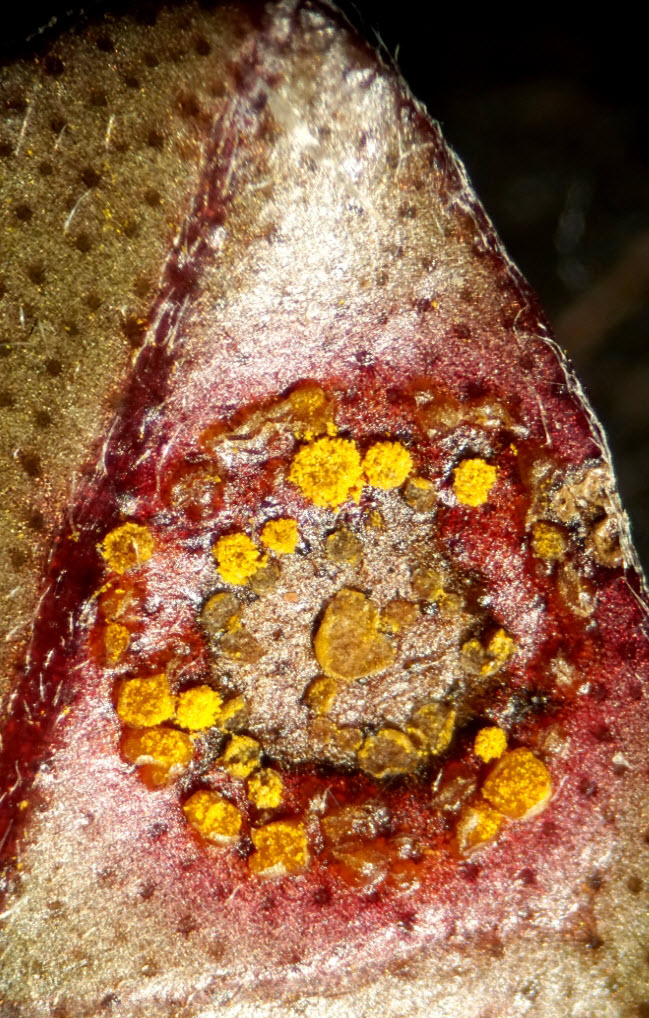
Bright yellow Myrtle Rust spore pustules on Chilean Guava plant, with die back of tip growth. Image courtesy of DPIPWE/Biosecurity Tasmania

Myrtle Rust on tip shoots with significant leaf and stem die back. Image courtesy of DPIPWE/Biosecurity Tasmania

Guava with close up of rust spores and rust pustules. Image courtesy of DPIPWE/Biosecurity Tasmania

Closeup of infected Lophomyrtus underside leaf surface, Rust lesion. Image courtesy of DPIPWE/Biosecurity Tasmania
Tasmanian news; December 2015
The Tasmanian myrtle rust response program that commenced in February 2015 continues with its efforts to eradicate the fungal disease from the state. MORE INFORMATION:
Discover more about how you can help, take a look at the FACT SHEETS: courtesy of DPI Victoria via DPIPWE
Look out for myrtle rust. Report it but don’t spread it. / Myrtle rust in the home garden / Myrtle rust – preventing the spread in bushland / Myrtle rust – Symptoms found on Myrtaceae plants in Victoria
If you see it, or think you have seen it?
At your earliest opportunity contact the Myrtle Rust Public Hotline: 03 6165 3785
– Remember do not touch the infected plant, the spores can be easily spread.
– Do not collect samples, take a photo of the infection instead.
– Record the location of the plant with a detailed description of the location or even a GPS coordinate if possible?
In Tasmania
The disease myrtle rust, Puccinia psidii, was discovered in Tasmania for the first time in February 2015. The disease was first confirmed in Australia in central New South Wales in 2010 and quickly spread up and down the east coast northwards to Queensland and south to Victoria where it was discovered at the end of 2011. The disease affects members of the Myrtaceae plant family which includes eucalypts, bottlebrushes and tea trees. It attacks new growth in affected plants and can in some cases lead to plant death. It has been found to attack over 200 native and exotic species in gardens and in the wild in Australia.
In Tasmania it has been found in selections of Lophomyrtus in private gardens and in Lophomyrtus, Chilean guava, Ugni molinae, and willow myrtle, Agonis flexuosa, in nurseries. The original diagnosis in Tasmania was on plants in a private garden in the Burnie area and by the end of May 2015 the disease had been confirmed in 70 private gardens and nurseries in the north, northwest and south of the state with the major outbreak in the northwest.
The RTBG has monitored its collections for myrtle rust annually since the disease was first discovered in Australia in 2010. Weekly surveys of the Gardens were undertaken by the Horticultural Botanist and Northern Team from February to May following the discovery of the disease in Tasmania with no sign of the disease found. The RTBG Myrtle Rust Procedures are currently being finalised with regard to the disease’s current status in the state.
Biosecurity Tasmania initiated an emergency response operation when the disease was first diagnosed in February with the mission to eradicate myrtle rust from Tasmania. RTBG staff have been involved in the myrtle rust response operation since the disease was found in February 2015. Curator Chris Lang and Horticultural Botanist Natalie Tapson were appointed as Inspectors under the Plant Quarantine Act and were seconded for three weeks each to work with Biosecurity staff and carry out surveillance of nurseries and private gardens in the north, northwest and south of the state.
The extensive plant identification skills of RTBG staff added another layer to the surveillance for likely hosts in the family Myrtaceae and Curator Lorraine Perrins, Team Leader David Marrison and Horticulturist Adam Lancaster each spent a week as part of surveillance teams in the south of the state.
Part of Biosecurity Tasmania’s response was to put a control area declaration in place across the state forbidding the sale and supply of Lophomyrtus and Chilean guava in Tasmania. The response team was demobilised at the end of May as the disease is inactive over winter and will resume as the conditions that favour the disease return in spring 2015.
Natalie Tapson
RTBG Horticultural Botanist
